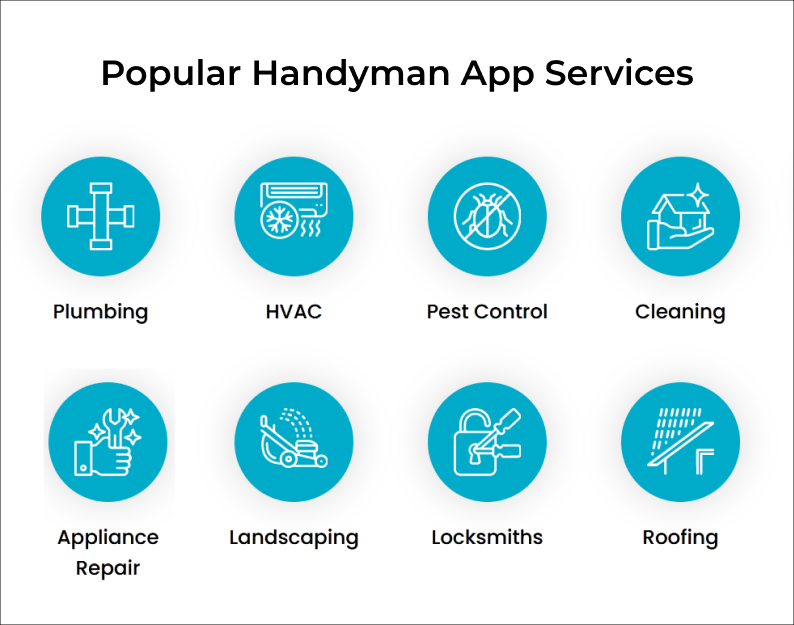A handyman business provides a variety of services to customers. These can range from carpentry, plumbing, and cleaning to electricity, gardening and landscaping. Establishing a network of interlinked servicemen to provide these services initially looks challenging during business planning, but can be handled well by adapting to the aggregate model.
What is an aggregate model?
An aggregate model is what powers the modern on-demand handymen apps. On these apps, multiple servicemen can sign up and offer their services. The app owner primarily earns through commission charges but there can also be secondary revenue streams.
Through this article, we aim to provide entrepreneurs with a thorough overview of how they can develop their own aggregate handyman app. First, let’s look at the key growth drivers of the industry.
Table of Contents
Why Develop a Handyman App: Market Overview and Key Growth Factors
Handyman services are distinctly required for construction work, house repairs, maintenance and renovation projects. In the past few years, the demand for handyman services has increased in both residential and commercial factors.
- As per statistics, the projected growth rate for the industry is approx. 17.2% CAGR in the period 2022-2032.
- The North American region is expected to be the largest market with a share of 36.5%.
- Followed by North America, Europe is expected to be the second largest market.
- The electricity segment amongst all handyman services is projected to have the highest market share with a CAGR of 21.34%.
Key Growth Factors Behind Handyman Services
- Rise in the number of private sector companies, which are 72% more likely to accommodate handyman services.
- Increase in the number of new residential and commercial construction projects.
- Increase in the number of millennial homebuyers.
- Need for renovation and repair work in old buildings and houses. As per statistics, around 80% of US homes are more than 20 years old and 40% are at least 50 years old.
- Regular maintenance and repair work of household appliances, plumbing systems, furniture items, gardening, roofing, etc.
Most Significant Players in the Handyman Services Industry
The leading players of the online handyman industry control diverse markets. However, being in its nascent stage, the industry is expected to see the rise of many new players who can capture more market share with accurate planning and timely launch. Till then, evaluating the top players can give you a better understanding of the business and help in handyman app development.
| Apps |
Launch Year |
Estimated Revenue |
| Angi |
1995 |
$1.6 billion |
| Bark.com |
2014 |
$455 million |
| Thumbtack |
2008 |
$300 million |
| TaskRabbit |
2008 |
$245 million |
| Handy |
2012 |
$216 million |
Services Delivered on a Handyman App
While carpentry, plumbing, assembly and electricity are key services delivered through a handyman app, there are also several other services that customers seek on the platform. The extent of these services depends upon the ever changing consumer demands, due to which the handyman app also has to accommodate the same.
Below are some popular services that you can find on a handyman app in 2023:

How a Handyman App Works: Exemplary Workflow
The workflow of a handyman app is simple to understand and implement. However, each and every business owner may be required to make adjustments in the workflow model based on his requirements and selected value propositions. For reference, you can take a look at the workflow example below:
- Service providers register themselves on the handyman app and list their services.
- Customers browse the app for service providers and schedule a service.
- Customers pay the service fee, which is inclusive of commission charges directly on the app (both service fee and commission charges are stored in the service provider’s digital wallet)
- The service provider coordinates with the customer through live chat or voice call and provides the service.
- Once a service provider reaches the minimum withdrawal limit, he can withdraw the amount from the digital wallet to personal bank account.
In case of service cancellations, reimbursements or cash payments, the service fee and commission are adjusted from the service provider’s digital wallet.
Revenue Generation Model of a Handyman App
The revenue generation model of any business depends on several factors such as consumer preference, spending patterns, competitor behavior and digitization. For example, if customers repeatedly opt for handyman services in your target market, then introducing subscription packages on your handyman app can be profitable. In contrast, if your services are one-time buy or see seasonal fluctuations, then you will benefit from upselling service add-ons.
Revenue generation streams on a handyman app:
- Service commission
- Subscription packages
- Featured listings
- Paid listings
- Service add-ons
- Late service cancellation charges
- Distance charges
Ready to Step Into the Handyman Services Industry
Must-Have Features in Your Handyman Mobile App
During the requirement gathering phase of handyman app development, you will be required to state your feature requirements that will be noted down in an Software Requirement Specification (SRS) document. SRS includes the list of all features along with their working and definition. At the time of testing and quality assurance of your handyman app, the working of all developed features will be tested against the definitions stated in the SRS. So make sure to add the following features in your SRS document:
- Booking Calendar: A booking calendar will allow customers to schedule a service and also prevent double booking.
- Profile Management: A complete module to allow service providers and customers create, edit and manage profiles. It should also have related features such as order history, customer support, wallet, help and more.
- Listing Management: Service providers should have the option to create multiple service listings and set fixed or hourly prices for the same.
- Search Filters: For simplifying navigation, your handyman app should provide search filters like distance, cost, ratings, experience, and more.
- Order Management: Service providers should be provided with a separate tab to see all orders, including both completed and pending ones. On the other hand, customers should get options for canceling orders, rescheduling orders and requesting refunds.
- GPS Navigation: The GPS navigation on your handyman app will allow service providers to reach exact locations for service delivery.
- Chat Module: A real-time chat module for allowing service providers and customers to chat and coordinate with each other.
- Ratings and Reviews: Ratings and reviews allow customers to select the most reliable service provider. They are also helpful in winning the trust of your customers. Likewise, service providers can also be given the option to rate and review customers to improve the overall experience for all service providers.
- Social Login: Allow both customers and service providers to register within a few steps with the help of their existing gmail accounts or social media profiles.
- Multiple Payment Options: To ensure conversions, it is important to provide customers with their preferred payment options. For this reason, your handyman app should provide multiple payment methods like eWallets, credit cards, debit cards, COD and more.
Admin Dashboard Features
The admin controls all actions on a handyman app through an online dashboard panel. This dashboard is often a web app that is synced with the customer and service provider’s mobile app. For appropriate business management and growth, your on-demand handyman app’s admin dashboard should have the following features:
- Tax Management: A module for the app owner to levy different types of applicable taxes depending on target regions.
- Content Management System (CMS): The CMS on your handyman app should allow you to personalize homepage, edit web pages, blog and all other content visible on the app. This includes the listings uploaded by service providers as well.
- Order Management: As the admin of the app, you should be able to view the order history and pending orders of both customers and service providers. Along with these, the admin should also get the access to see payment status and initiate refunds for each individual order.
- Discount Management: The admin should have features to provide fixed or percentage discounts. Apart from this, your discount management features should be inclusive of coupon code management and reward points.
- Notifications and Alerts: The option to control and set multiple notifications and alerts that are automatically sent to the customer and service provider on the completion of several triggers, such as on booking a service, adding a service to cart, on exit-intent, etc.
- Commission Management: The handyman app owner mainly earns through service commissions. He should be able to set his own fixed or percentage commission rate, which can vary from service to service.
- Payment Gateway Management: Different payment gateways come with different transaction charges. The admin should have the option to add, remove or disable payment gateways based on transaction charges and customer preference.
- Reports and Analytics: Reports and analytics features will assist you in finding the top performing services, total revenue generated, most preferred target audience and many more business stats. These will help you in enhancing your marketing strategy and making important business decisions.
- Marketing Management: The marketing management module should include features like meta tag optimization, social media sharing, banner management, featured listings, and more.
How to Develop your On-Demand Handyman App?
Just like any other app, handyman app development follows the Software Development Life Cycle (SDLC) process. The SDLC process is a predefined set of multiple software development stages that include various activities, deliverables and the complete framework. The main purpose behind SDLC is to create high-quality software while refining the development process so that the entire project is completed with time and cost efficiency.
Different Stages your Handyman App Will Go Through:
- Requirement Gathering: This stage will include the creation of the SRS document and set the base for the entire development process. The key people involved in this stage are business analysts.
- Feasibility Analysis: Again the business analyst will evaluate the business requirements against certain criteria like required resources, technologies, timeframe and costs, etc. These will test the feasibility of the project within the allocated hours and budget.
- Design Phase: In this stage, the design and development team will prepare the base structure of your handyman app. For example, user interface, backend database, feature list and security measurements. Everything will be noted in a Design Document Specification (DDS) document.
- Development Phase: This phase will cover the transition of the design into source code. The development phase heavily relies on SRS and DDS.
- Testing Phase: After development, your software will go to the quality assurance team who will perform various tests like unit tests, integration tests, functional tests, smoke tests, etc.
- Deployment Phase: The handyman app will be finally deployed on your servers and made available on app in this stage.
- Maintenance Phase: The maintenance phase includes releasing updates and bug fixes for the app.
Develop Meaningful Apps with FATbit Mobile Development Services
Summing Up
Launching any type of business requires persistent efforts and rational decision making. One also needs to prepare a business strategy for the long run. Similar is the case with the handyman industry. Where the industry is growing at an impressive pace, many startups are ready to capitalize on the opportunity. It is highly advised to develop and launch your handyman app at the right time to get a competitive advantage. You can share your requirements with our experts to get started on your handyman app and also check out our insights to gain more info on handyman app development.




Comments (1)
 Jackson
Jackson
Great Blog! Thanks for sharing this awesome knowledge with us.